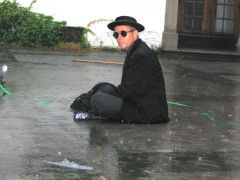FLASHBACKS, described by some psychotherapists as traumatic experiences,can also be experienced positively, as liberating moments of detachment from depressing reality.
- FLASHBACKS by Timothy Leary
I consider the HERMIT symposiums, rooted in the tradition of alternative culture, among the most important activities of the 1990s in Czechia. After 1989, majority of local artists hoped to get aligned with official Czech institutions and to be embraced in the West, while Hermit was one of the few activities not focusing on cultural establishment. Although it had some support by grants, it retained the features of an unofficial events held during the "normalisation years" of the 1980s. The uprooting that we had to deal with after the collapse of the "real-socialism" and actually after the disintegration of the underground, the opposition and all structures, created an urgent need to search for new foundations.
VELVET REVOLUTION brought many of the alternative and dissent artists into leading positions, while the former protagonists mostly retreated into the "background". With the rise of a new generation of descendants, both the former regime protegees? (Mikoláš Axman, Petr Nikl, Dominik Lang, Martin Zet, Veronika Bromová...) and their former opponents (Tobiáš Jirous, Jáchym Topol, David Němec, Ivan Kafka, Gábina Fárová...), the situation changed over the course of the decade, first full of idealism, then diluted by the relativisation of values.
The beginning of the 1990s was a time of unprecedented freedom for everyone. Our experience of the hitherto forbidden global world shifted some of us for rediscovery of domestic roots, to a renewal of the ties to our own cultural heritage, that had been severed by totalitarianism. From the Czech tradition of alchemy (to which I dedicated my intervention Three in One in Plasy), to the then current production of the undetectable explosive Semtex, infamous among terrorists around the world and moving international security policy. It is worth remembering that in the communications field during the 1990s there were also major shifts from landlines to mobile phones, in video the transition from analogue to digital, and after 1995 the deployment of the Internet.
At the same time that Hermit started its activities, the first decentralised non-Prague faculty of fine arts was founded. Woody Vašulka, who returned from emigration (together with his wife Steina), initiated annual exhibitions and symposia of Hi-tech/Art in Brno. The historic exhibition of new media art Orbis Fictus (with Miloš's contribution) was held at the National Gallery in Prague in 1996, still under the auspices of the Soros Centre for Contemporary Art, before Soros was expelled from the country by conservative leaders after a futile attempt to establish the Central European University here.
Hermit fade out at the same time as the Hi-tech/Art and the Vasulka's activities, which ended around 1997, with the end of sponsorship due to the financial crisis and the austerity economic packages introduced by Prime Minister Václav Klaus. These strangled not only the cultural scene but also the developing new school system. Symptomatic was also the transformation of the National Gallery, where in 1995 (under the direction of Jaroslav Anděl, also a former emigrant) a new permanent exhibition was inaugurated, including a comprehensive overview of Czech action art.
Almost immediately after Milan Knížák took over as director in 1999, it was decimated. Milan Knížák (director of Fluxus East from the 1960s) represented a return to forceful, undemocratic principles of power hegemony. The paradoxical development in international relations can be illustrated by the history of BLACK MARKET. Initiated from the East, founded in Poland in the mid-1980s, the EAST-WEST PROJECT, as an open structure of network cooperation overcoming the IRON CURTAIN, was built on the anti-hierarchical principles of free creative dialogue. However, natural misunderstandings due to communication noises, but also the collision of different cultural habits, gradually resulted in a kind of Western paternalism. The originally equal representation of Eastern artists was replaced by the dominance of Western Europeans. Of the founders, Piotrowski had already given up his collaboration before the VELVET REVOLUTION, and my participation was terminated after the 1990 tour.
The direct clash with Boris Nieslony was caused by my suggestion to invite Marina Abramović, whom BM met that year at the New Territories festival. Not long after breaking up with Ulay, she was open to performing with BM, but the proposal didn't go through. Some seemed to be intimidated by her power. Following transformation (initiated by Nigel Rolfe) into an exclusive group with the trade-mark BLACK MARKET INTERNATIONAL, in 1991 bookended an eight-man line-up for a decade. At its end, the last Eastern European, Zbygniew Warpechowski, was excommunicated.
HERMIT was not attended by BMI, but some members came individually (MacLennan, Warpechowski, Vaara, van Poppel). Only after the crisis in 2000 did the BMI group open up gender-wise and overcome its Euro-centrism, stretching from Asia to America (as Piotrowski proposed from the beginning). Among Europeans, nevertheless, the German section has expanded and dominated. Boris Nieslony has become a decisive factor and is revered by some members as a leader with a founder's myth.
Alongside this development, there is a parallel history of the BLACK MARKET MOVEMENT. In Czechia the BM OPEN SITUATION performance was organized during the perestroika Mir Caravane in 1989 and in the Performance section of the Prague Quadrennial 2007, thus in a theatrical context. Offers to fine art institutions (the National Gallery and Rudolfinum) have not yet met with a positive response. However, this tradition is alive, because it is not just an experimental art project, but above all a socio-cultural and political model whose basic principles are still relevant and prospective.
Long Live BLACK MARKET MOVEMENT!
Tomáš Ruller, November 2023
